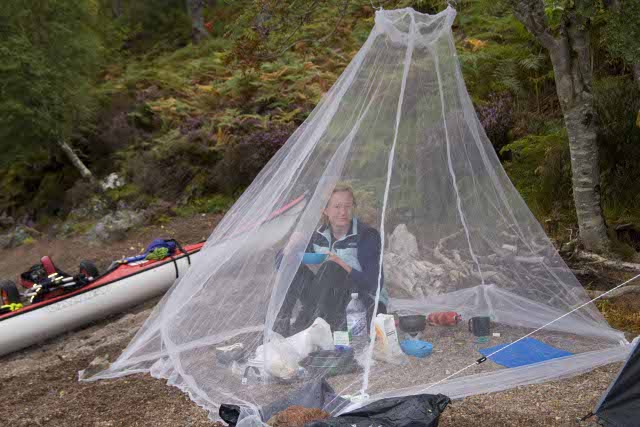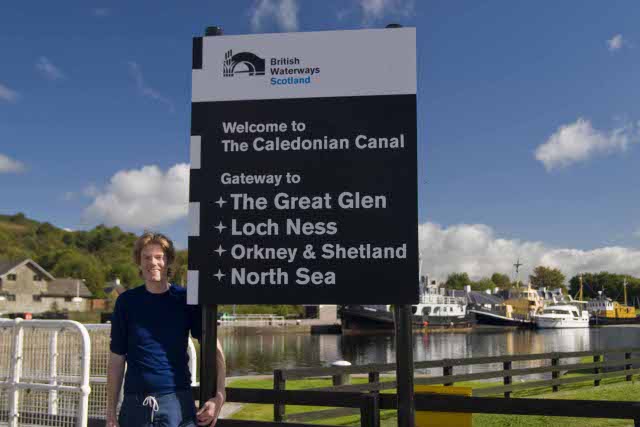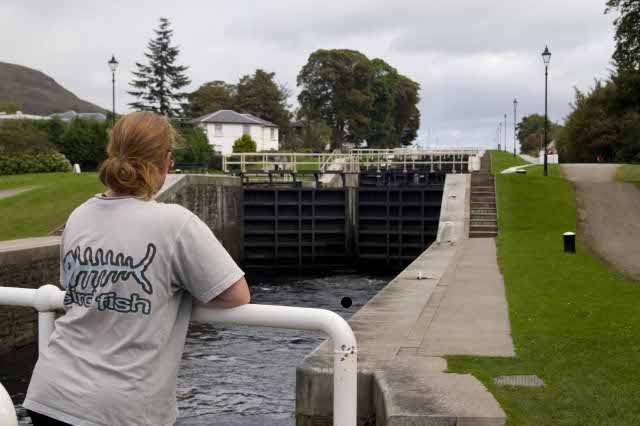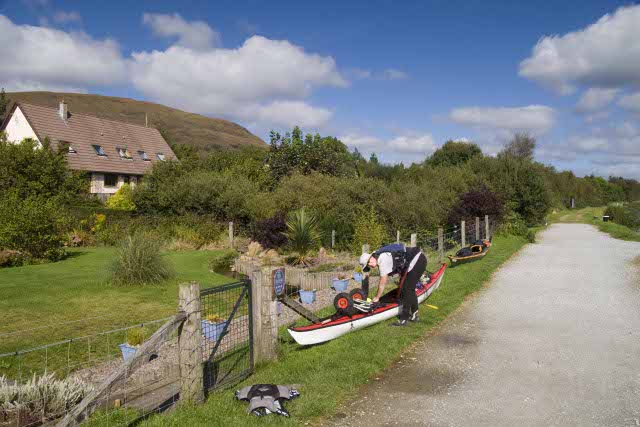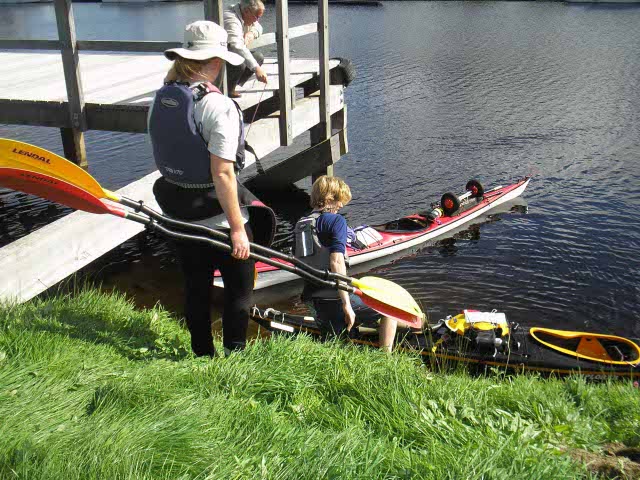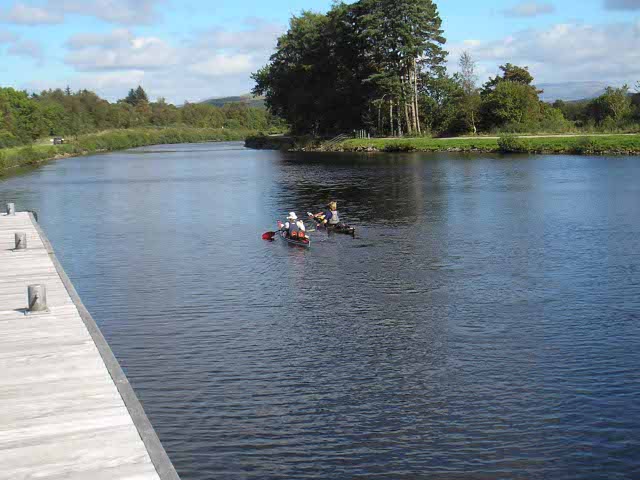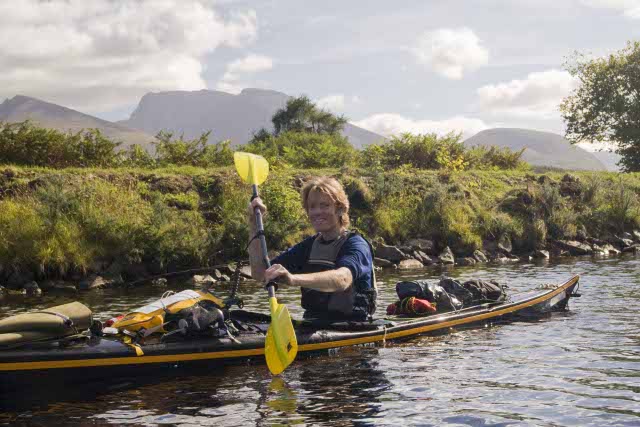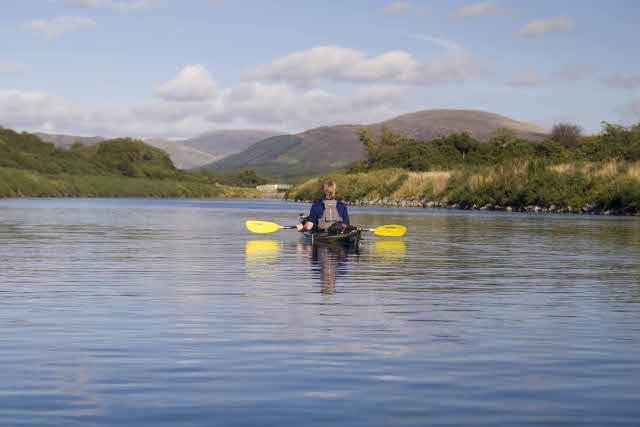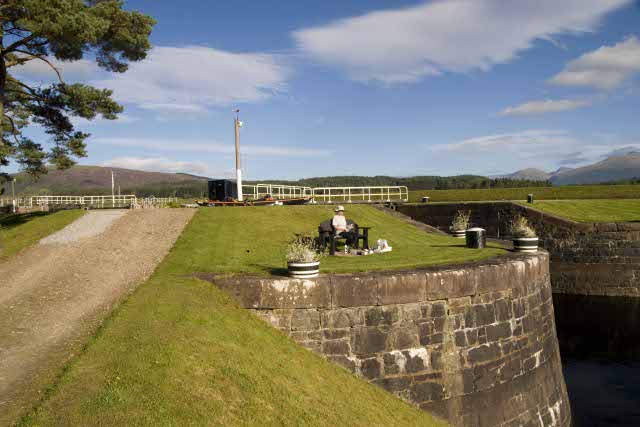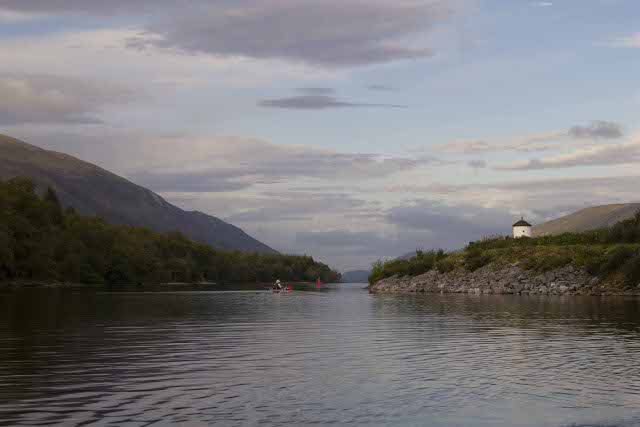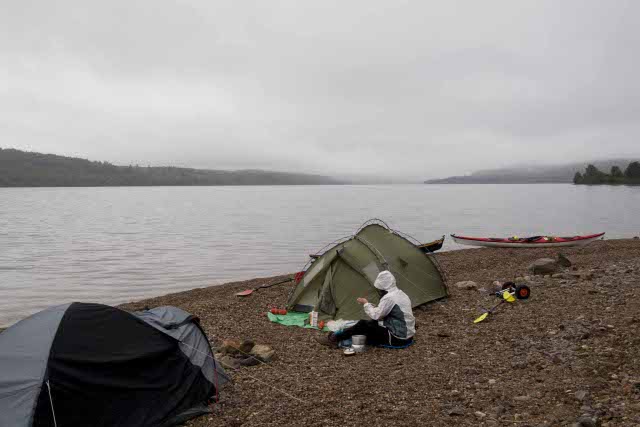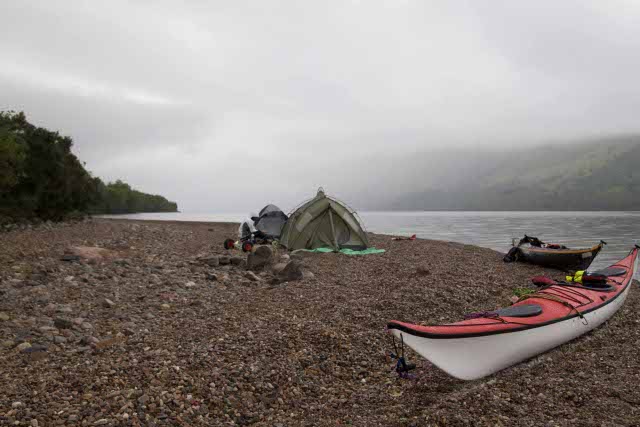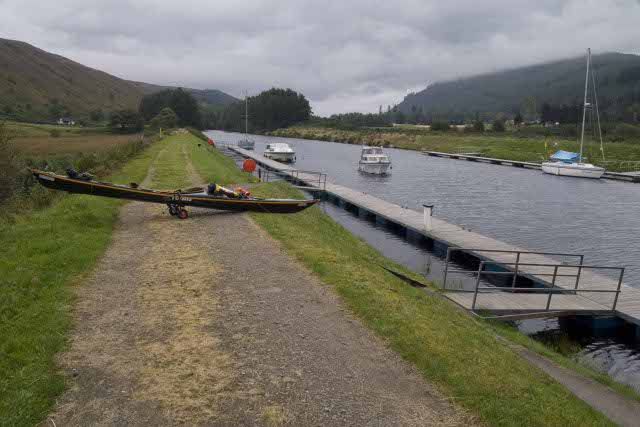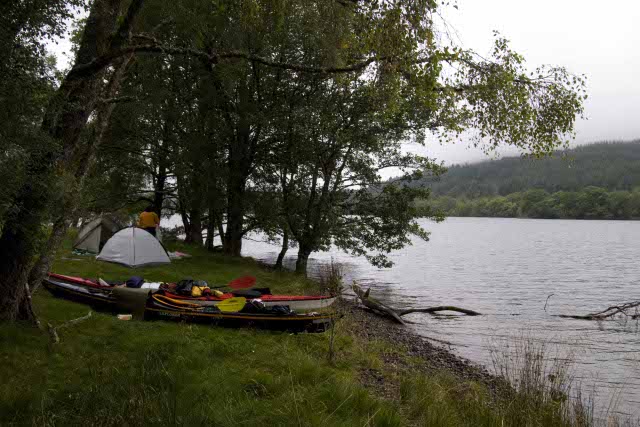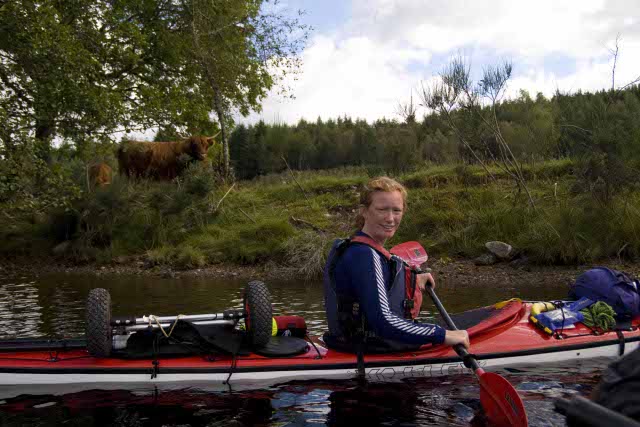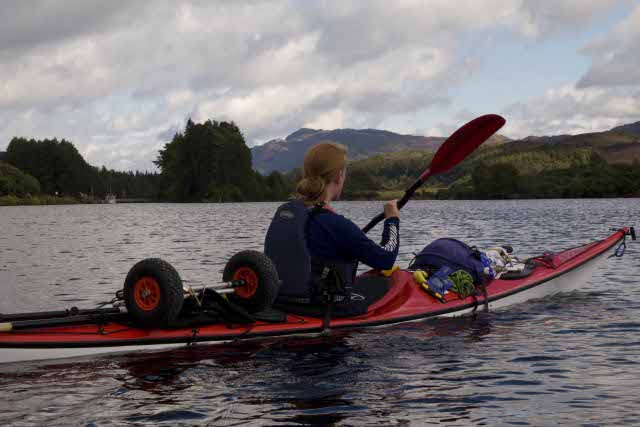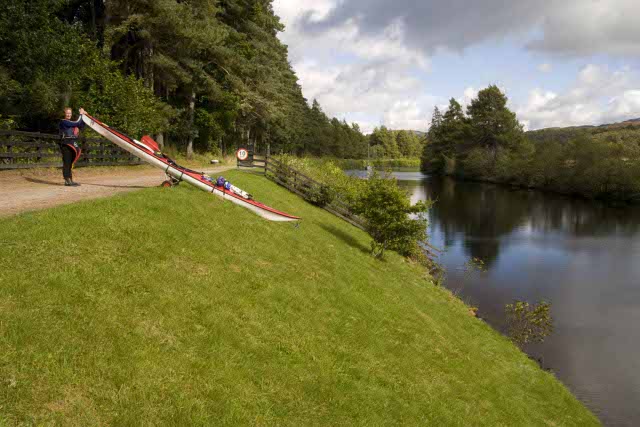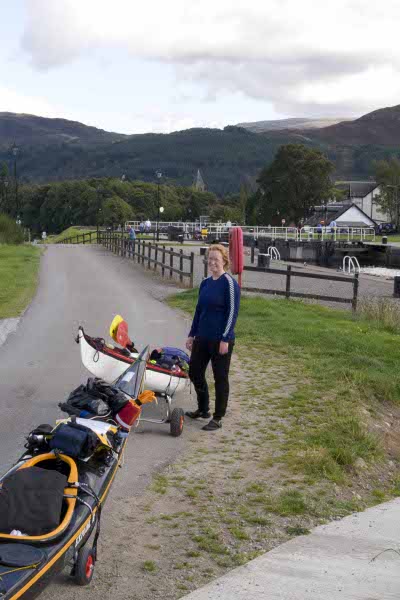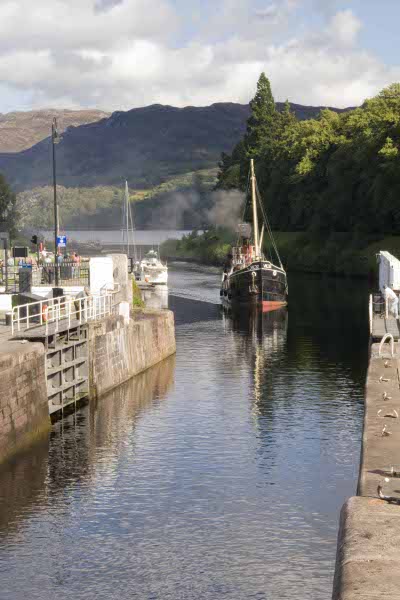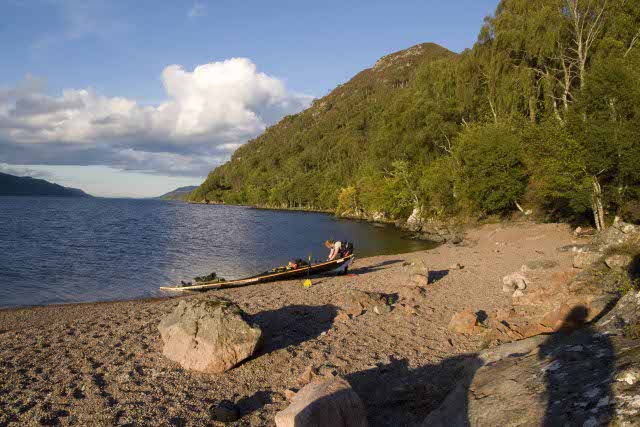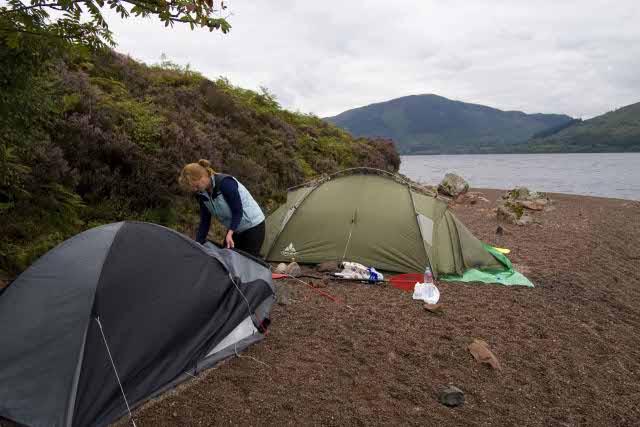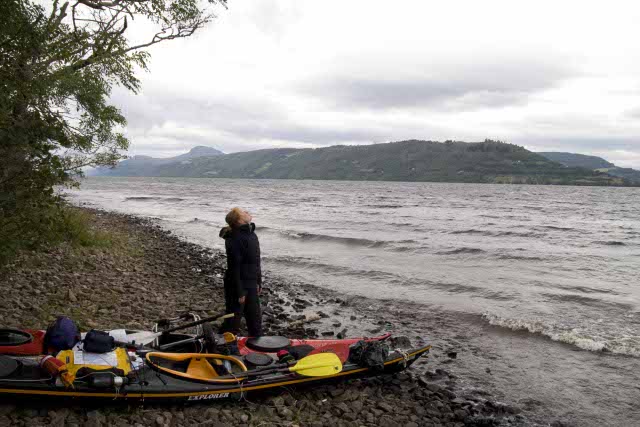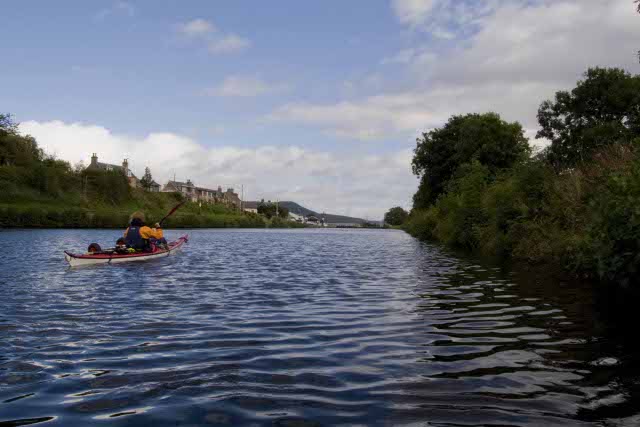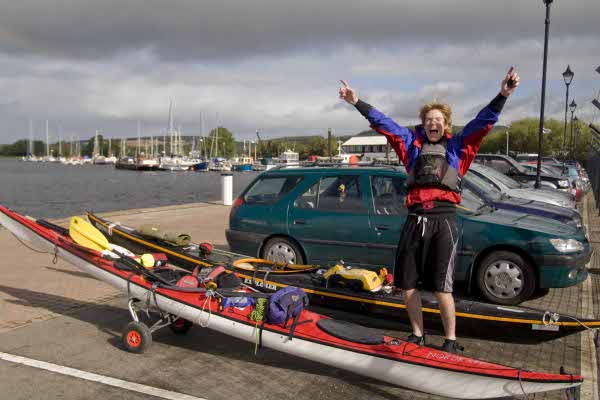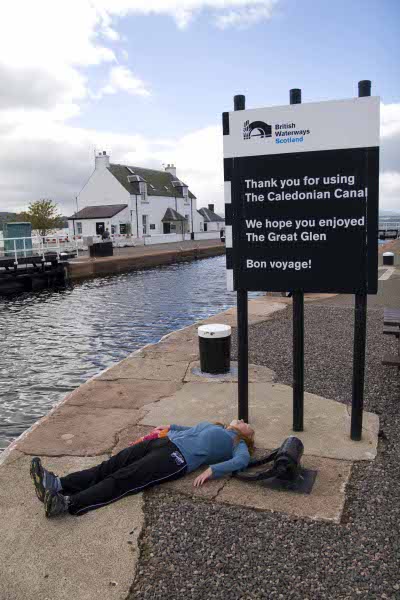Getting to Scotland The Shuttle Sunday was put aside for the shuttle. We had pre-arranged to leave our boats and kit in the back garden of the Glenshian Guest House Bed and Breakfast at Banavie near Fort William, which backs onto the canal just above Neptune’s staircase. After unpacking what seemed to be huge amounts of gear, we drove up to Inverness and parked in the Seaport Marina car park which is free of charge for those using the canal. We also visited the canal office and picked up our free licence, skippers guide and key to the British Waterways toilet/shower blocks. The two hour Citylink bus journey was our lift back to Fort William. We returned to the Glenshian Guest House for our last night of luxury before embarking on the 60 mile paddle north. DAY 1 The Launch
Kayakers are not allowed through any of the Caledonian Canal locks and so in order to avoid a long portage we decided to start the trip above the series of locks at Banavie known as Neptune’s Staircase
After picking up some last minute supplies in Corpach, we walked back to Banavie and launched the boats. With wheels bungeed on the back and camera tripod bungeed on the front, we were off.
The first section of the canal from Banavie to Loch Lochy was quiet and very scenic, with great views to the Nevis Mountains
After passing some walkers, cyclists, hooded crows and a kingfisher, we reached our first portage, Gairlochy lock.
Upon the approach to the locks, we noted a suitable place to egress with the fully loaded boats on the right-hand side of the canal. However, the loch keeper suggested that we portaged on the opposite side of the canal. We followed his instruction and thereby had to lift the boats over a series of sharp craggy rocks and then up a steep grassy bank. (After this experience, we portaged where we thought was most suitable and not where the loch keepers suggested.) Following the portage, we entered our first loch, Loch Lochy.
As a rule, we paddled down the lochs on the opposite side to which ever side the main road was on. Hence, we paddled the Northern edge of Loch Lochy and took in the amazing scenery. The water was calm, the evening sky pretty and all was peaceful. We set up camp on a gravel beach approximately one third of the way up the loch and had a very peaceful night. Day 2 The Midges
Following fried egg (with added midges) and cereal for breakfast, we set off on a fairly breezy Loch Lochy. As we paddled north east, the southwesterly wind increased to such an extent that we almost managed to surf off the Loch and up to the next portage at Laggan locks.
According to our skippers guide Laggan locks has showers and a water point. Now, technically, this is true. However, after attempting and failing to get even luke warm water out of the showers, the loch keeper informed us that the showers had ‘probably run out’ of hot water. OK, lets just fill up the drinking water then. No banana there either. The water was definitely not drinking water. In fact, there were even signs up warning you not to use it when brushing teeth. Straight out of the canal perhaps? In light drizzle we set off towards Loch Oich and shortly after the swing bridge, spotted the Seven Heads village store situated on the northern bank of Loch Oich prior to reaching Invergarry. This shop sold everything from deodorant to meths. After stocking up on drinking water and downing a warming lunch of soup and cake, we took a stroll to the monument at seven heads, comprising of, surprisingly, seven heads. Seven Heads is so called because the severed heads of seven murderers belonging to the Macdonald clan, were washed in the spring at Seven Heads prior to presentation of the heads to Lord Macdonell in 1665. Mmmmm nice. After a long lunch stop, we paddled lazily on up Loch Oich and found a nice grassy camping spot on the eastern edge of the loch, between the loch edge and great glen way.
The evening was sunny and this time we erected a mozzy net to cook dinner in which was a big improvement. After a few whiskys and games of cards, it again was a very peaceful night, with just the sounds of owls to keep us company. Day 3 Fort Augustus
The portages at Cullochy loch and Kytra loch involved pontoons and grassy banks and were thankfully not too boat scraping.
Soon we reached the enormous conurbation of Fort Augustus. OK, it’s neither enormous nor a conurbation but it is the biggest place en route and does have a couple of cafés, pubs, a small supermarket and a chip shop. What more could you want? Fort Augustus separates the Caledonian canal from Loch Ness and consists of a small loch staircase which needs to be portaged.
Here, we found great British Waterways facilities and I had a fantastic shower with oodles of hot water. There are also toilets, water points, rubbish points, and even a British Waterways laundry! The Caledonian Canal visitor centre at Fort Augustus (free admission) is also worth a visit, where you can read about the history of the canal and also pick up the latest weather forecast. After lunch in the Moorings café, we stocked up on supplies (not that we needed it but it seemed rude not to) and headed out on to Loch Ness. With a light south-westerly breeze behind us and the sun shining, we paddled out towards the centre of the water and admired an absolutely beautiful Loch Ness. As the sun lowered in the sky, we began looking for camping spots on the eastern side of the loch (the opposite side to the main A82). Initially, the eastern shore was steep sided providing awesome scenery but very few potential camping spots. However, as we travelled up the loch, the mountains became gradually lower and periodically we would pass small beaches. Eventually we stopped at a fantastic ‘desert island’ beach on the eastern shore, where we set up camp. The beach was flat, sheltered and had ample wood for camp fires.
Day 4 Nessie shows her dark side After leaving Foyers bay, the wind continued to increase to the point where gusts were threatening to take the paddle from my hands. The waters of Loch Ness (apparently) never reach higher than 6°C and neither of us really fancied an unplanned roll or worst of all, swim. Therefore, after a couple of unplanned bongo surfs, we pulled up on a rocky beach for a break. Tired and a little damp, we both staggered up the beach towards some woodland, only to see a pine martin trotting along the edge of the woodland without a care in the world. I can only think that despite being dressed in bright orange and red, it didn’t see or hear us coming. On previous Scottish holidays I had always looked for pine martins but had never been lucky. Hence (being a Biologist), I was very excited by this pine martin encounter.
As we sat in the woods and had an early lunch, the wind increased further and 3ft waves rolled onto our small beach. We decided to ‘sit it out’ until conditions improved. The beach was situated just down from ‘General Wade’s Military Road’ near a picnic place and a couple of woodland walks with views of Urquhart castle on the opposite side the loch. As the weather closed in, walking boots and waterproofs were dug out of hatches and with a packed rucksack, we headed off into the woods to search (unsuccessfully) for more pine martins. Six hours later, just as it seemed that we would be camping on our unplanned beach, the wind dropped slightly and we seized the opportunity to get a further hour of paddling in before dusk. However, after launching, it was soon clear that the wind had not dropped as much as we thought it had so we spent much of the hour rafted up for stability and drifting up the loch, keeping close to the shore. As a kayaker, I have never intentionally travelled very far as a raft. However, in the strong winds of Loch Ness, this method of paddling was remarkably efficient and at one point we even reached a respectable 4 mph! However, with one person steering and the other holding the raft together it is easy to get cold, as you are not paddling in the usual way. As dusk started to move in, we pulled up on a rocky beach and (both being reasonably chilly by this point) we hurled up Dan’s tent (the larger of the two tents) and jumped inside with sleeping bags, dry fleeces and a bottle of whiskey to warm up. (OK, I know that whiskey does not really warm you up but we were not hypothermic and it felt good). After attempting to cook a delicious looking omelette but unfortunately finding that the last egg we cracked into the pan was bad, we resorted to some emergency pasta and called home for an update on the latest weather forecast. Tomorrow, force 6 rising to gale force 8 in the afternoon. Great. We decided to get up a 5am the next morning……….. Day 5 Nessie gives us a reprieve As we entered the last stretch of Caledonian Canal, we were both hungry, but also relieved, knowing that bar a hurricane, or severe injury, we would be able to complete our Great Glen paddle. The canal was sheltered, serene and quiet, with fluffy ducks and picturesque pontoons, a world away from the wind and waves of Loch Ness.
After breakfasting at our last portage at Dochgarroch loch, we continued on up to the Muirtown lochs at Inverness. Our final egress point was just south of the Muirtown loch flight, a short and easy portage from the seaport marina car park. Tired but satisfied, we unloaded the boats and filled the car with wet gear.
After a shower and change at the British Waterways block, we returned the key to canal office and did the short walk from the car park up to the Clachnaharry Sea lock, at the very end (or start) of the Caledonian Canal.
Our trip was complete. This is the most varied and scenic trip that I have ever paddled and I would thoroughly recommend it as a ‘must do’ trip. Essentials for the trip Additional resources Waterscape.com - Britain's official guide to waterways. Caledonian Canal - a guide from the SCA with a mass of detail on this trip. "Exercise Damp Cadet" - Kayaking the Caledonian Canal - from Canoe Focus. Contributed by Claire Cailes
|
